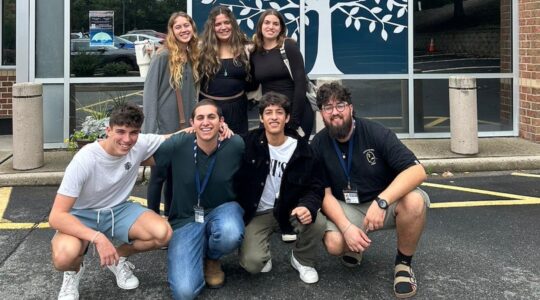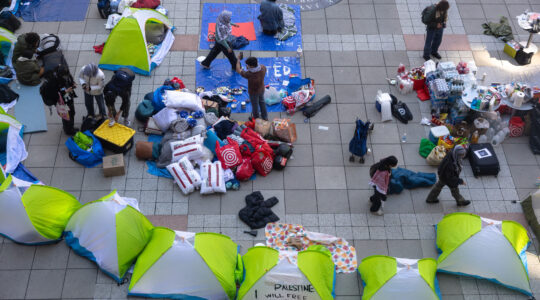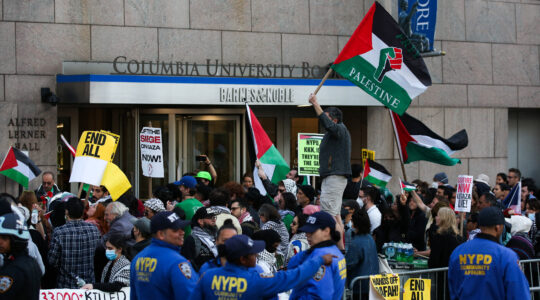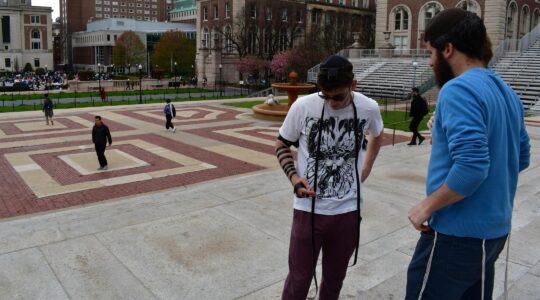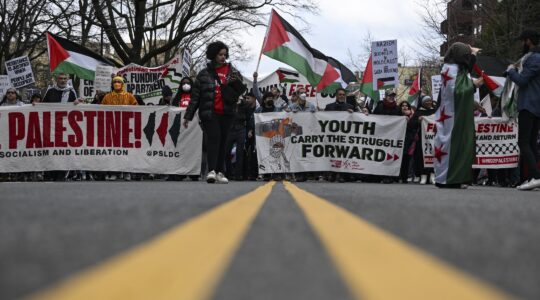The Jewish service learning movement took center stage Monday in New Orleans at the General Assembly of the Jewish Federations of North America.
Monday marked the first time that the federation system offers a large-scale day of service as part of its annual conference.
The day of service featured volunteer opportunities in St. Bernard Parish, which was hit hard during Hurricane Katrina, as well as a number of learning opportunities focused on how the $30 million the federations raised in the aftermath of Katrina have been used. The day was s a joint effort between Jewish Federations and Repair the World, an organization barely more than a year old.
Launched 16 months ago with great fanfare, Repair the World is backed by some of the biggest names in Jewish philanthropy: the Schusterman Foundation, Einhorn Family Charitable Trust, Jim Joseph Foundation, Nathan Cummings Foundation and Rob Bildner, a founding board member who has served as a key leader of the organization
Repair is trying to position itself at the center of the burgeoning Jewish service learning world — as its hub, quality control outfit, primary PR agent, research center and benefactor. The organization already is channeling millions of dollars from funders to organizations involved in Jewish service learning, the organization’s CEO, Jon Rosenberg, told me last week in New York.
So, what is Jewish service learning? Learning about social problems through collective, non-competitive experiences centered on figuring out how to solve a real social problem. The movement, begun a century ago, has spawned the Peace Corps, the Urban Corp and Teach for America, among other initiatives. [[READMORE]]
It’s important to understand that the goal of such programs usually extend beyond the immediate experience. So, for example, Teach for America is not just about spending time in the classroom, it’s also creating long-term advocates for education reform. In the Jewish context, service learning has become a way to build Jewish community around solving social problems and infusing volunteer work with Jewish teachings.
The Jewish world for decades has held what are commonly known in the community a “mitzvah days” — daylong community service ventures. But in recent years, organizations such as Hillel, the American Jewish Joint Distribution Committee and the American Jewish World Service have begun offering short-term programs that take young people to distraught areas of the world; now these organizarions and others have even begun offering long-term programs for up to a year.
Repair the World is trying to expand the field of such organizations with a Jewish Service Index. It will map the organizations currently involved in service learning, identify commonalities, and then create standards of practice and measurable outcomes. This will help illuminate the organizations’ impact in the communities they seek to help — and the impact the work has on the volunteers themselves.
Some 3,000 young Jews are now involved with 18 organizations Repair counts among its grantees. About 2,500 are involved in short-term and medium-range programs, lasting between a week to five months, and about 500 are involved in longer programs. In total, it takes between $12 million and $15 million to support those programs each year, Rosenberg estimates. Nearly all of the funding comes from philanthropic support.
To boost participation, the programs must become more affordable, he says. Repair is trying to figure out if some programs can find homes in universities, get corporate support or government backing. On average, it costs about $2,500 per participant in a short-term program and up to $15,000 for a year-long program.
More philanthropic support, he says, is necessary. But, he adds, philanthropy "can’t be the only answer."
"In this climate," he says, "to be sustainable means something more than just raising more dollars."
In conjunction with its effort to expand the field of Jewish service learning projects, Repair is using a mixture of social marketing and ambassadorship to push the idea that service is an important part of being Jewish.
It is also supporting Jewish programs involved in social innovation, including Challah for Hunger, a project of Eli Winkelman that enlists college students to bake and sell challah and give the proceeds to food charities, and Rabbi Jill Jacobs, who is trying to bring service learning to Jewish day schools.
Overall, Repair is trying to mainstream volunteerism back into the Jewish world.
Though it has given out more than $3 million in grants during its first two grant cycles, the organization has had a relatively low profile.
That is about to change.
In a few weeks, the organization will release its first major study, which looks at the impact Jewish service learning projects have on recipient communities. It is also discussing with the Jewish federation system how to build a Jewish volunteer structure that could quickly mobilize skilled volunteer responders the next time a tragedy like Katrina or the Haitian earthquake hits — so that in addition to raising money, federations can send manpower, too.
The organization is also working with Moishe House, which sets up shared residences for young Jews who use the occupancies to offer informal Jewish programing. Repair would like to help that organization create a dedicated internal resource to help residents of local Moishe House outposts find volunteer opportunities. Repair is also working with the University of Washington to create a course — set to start in fall of 2011 — about social action, social service and social justice in Jewish history. It is a model Rosenberg hopes other universities will follow.
Rosenberg also wants to tie in Jewish service projects with secular service projects.
Repair, which gave out $2.6 million in grants this year, will base its grant-making on whether organizations stand up to industry standards, he said.
Fundermentalist’s Take: The key to the success of building the service learning sector is ensuring that it’s not only about building Jewish identity, but that the projectshave actual value and impact on the communities they’re meant to serve.
“This is not Birthright,” Rosenberg says. “If the goal was simply to create the next generation of Jews committed to x, y or z, committed to the federation, or marrying a Jew, or engagement with the State of Israel — if the goal was simply that, there are probably programatically easier and less expensive ways of doing it.”
This issue is particularly a sticking point with day-long and short-term projects, which even those in the Jewish and non-Jewish service learning industry admit often cost more in dollars and preparation hours than is the actual impact from the service provided by volunteers.
But , Rosenberg says, the goal is also to create "Jewish citizens of the world who take seriously the obligations of caring and of justice of chesed and of tzedek."
So is Jewish service learning for the federation system?
Some federations clearly think so. UJA-Federation of New York has helped send hundreds of young adults on immersive service learning programs with Hillel and the AJWS through the federation’s Break New Ground program, Rosenberg notes.
But the federations can be tricky entities. While most want to provide authentic programming, federations by their nature are fund-raising organizations, and almost everything they do is in one way or another tied into raising money. Mitzvah days and service days tend to become more about providing feel-good experiences for potential donors than carrying out high-impact projects to help cure a social problem.
In New York, Rosenberg believes that the federation has been able to divorce the program from fund raising.
“I don’t think they view that as a form of donor engagement,” he says. “They do it because it is part of what that organization sees as consonant with its mission.”
Other federationsm, he says, might not be in a financial position to take such an approach. Still, he adds, they could take a harder look at how to be more effective in utilizing volunteers. He advocates getting federations to incorporate volunteer opportunities into their Human Resources departments and figuring out how to mobilize volunteers, especially on behalf of their partner agencies.
